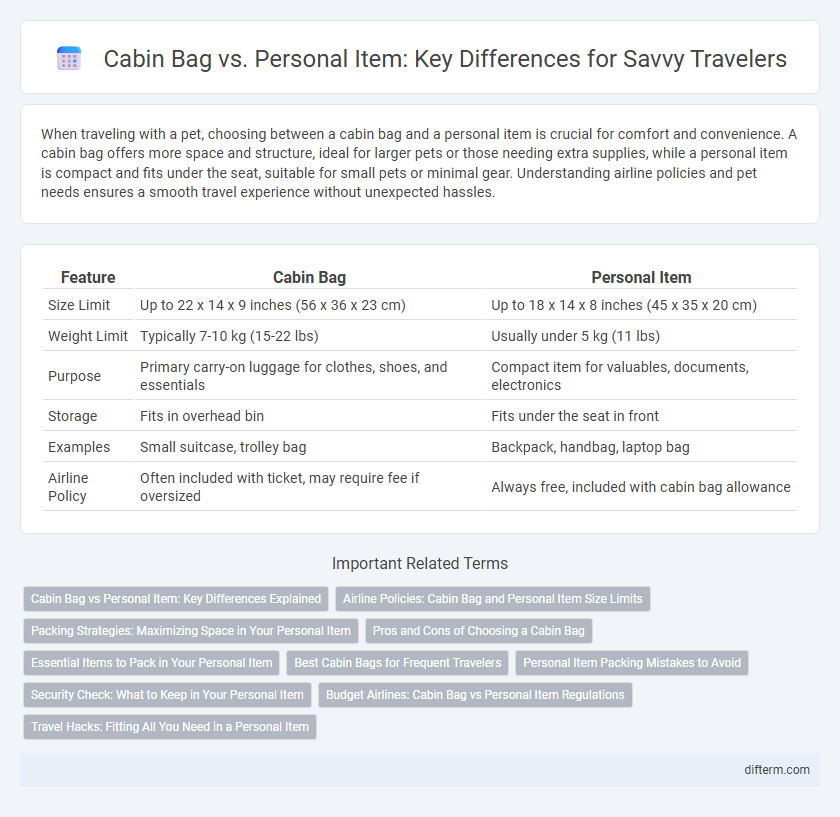When traveling with a pet, choosing between a cabin bag and a personal item is crucial for comfort and convenience. A cabin bag offers more space and structure, ideal for larger pets or those needing extra supplies, while a personal item is compact and fits under the seat, suitable for small pets or minimal gear. Understanding airline policies and pet needs ensures a smooth travel experience without unexpected hassles.
Table of Comparison
| Feature | Cabin Bag | Personal Item |
|---|---|---|
| Size Limit | Up to 22 x 14 x 9 inches (56 x 36 x 23 cm) | Up to 18 x 14 x 8 inches (45 x 35 x 20 cm) |
| Weight Limit | Typically 7-10 kg (15-22 lbs) | Usually under 5 kg (11 lbs) |
| Purpose | Primary carry-on luggage for clothes, shoes, and essentials | Compact item for valuables, documents, electronics |
| Storage | Fits in overhead bin | Fits under the seat in front |
| Examples | Small suitcase, trolley bag | Backpack, handbag, laptop bag |
| Airline Policy | Often included with ticket, may require fee if oversized | Always free, included with cabin bag allowance |
Cabin Bag vs Personal Item: Key Differences Explained
Cabin bag and personal item differ primarily in size and purpose, with cabin bags typically allowed dimensions around 22 x 14 x 9 inches and personal items being smaller, such as a handbag or laptop bag. Airlines usually permit one cabin bag plus one personal item per passenger, where the personal item fits under the seat while the cabin bag goes in the overhead bin. Understanding these size restrictions and storage locations ensures efficient packing and a smoother boarding process.
Airline Policies: Cabin Bag and Personal Item Size Limits
Airline policies strictly define cabin bag and personal item size limits to ensure efficient storage and safety compliance during flights. Cabin bags typically measure around 22 x 14 x 9 inches, while personal items must fit under the seat with dimensions near 18 x 14 x 8 inches, though exact sizes vary by carrier. Passengers should consult their specific airline's guidelines to avoid fees or boarding delays caused by exceeding size restrictions.
Packing Strategies: Maximizing Space in Your Personal Item
Maximizing space in your personal item involves strategic packing techniques such as rolling clothes tightly, using packing cubes, and selecting versatile, lightweight garments. Prioritize essentials like travel documents and electronics in easily accessible compartments to optimize convenience and efficiency. Employing compression bags or packing organizers can significantly increase capacity while maintaining order and minimizing wrinkles.
Pros and Cons of Choosing a Cabin Bag
Choosing a cabin bag offers the advantage of more storage space for clothes, electronics, and essentials while adhering to most airline size regulations, which enables travelers to avoid checked baggage fees and waiting times at baggage claim. However, cabin bags can be bulkier and harder to stow in overhead compartments on fully booked flights, potentially causing inconvenience during boarding and disembarkation. The choice depends on balancing the need for carrying capacity with ease of mobility and compliance with specific airline policies on hand luggage dimensions.
Essential Items to Pack in Your Personal Item
Your personal item should include essentials such as travel documents, a wallet, and a phone charger to stay organized and connected during your trip. Compact necessities like medications, a small toiletry kit, and snacks ensure comfort and convenience on the go. Including a lightweight jacket or scarf also helps adapt to changing temperatures in airports and planes.
Best Cabin Bags for Frequent Travelers
Choosing the best cabin bag for frequent travelers means prioritizing lightweight, durable materials and compact design to fit airline overhead compartments. Cabin bags with multiple compartments and TSA-approved locks enhance organization and security during quick airport transitions. Opting for bags with smooth-rolling spinner wheels and adjustable handles reduces fatigue and streamlines mobility through crowded terminals.
Personal Item Packing Mistakes to Avoid
Overpacking a personal item often leads to difficulties fitting it under the seat, resulting in last-minute gate check fees or inconvenience. Common mistakes include choosing bulky or rigid bags that don't maximize the allowed dimensions, and failing to pack essential travel documents or electronics in easily accessible compartments. Streamlining your personal item with lightweight, flexible storage and prioritizing essentials ensures compliance with airline policies and a smoother travel experience.
Security Check: What to Keep in Your Personal Item
During security checks, it's crucial to keep essential items like passports, boarding passes, wallets, and electronic devices in your personal item for easy access and efficient screening. Airlines typically allow one personal item that fits under the seat, making it a secure spot for valuables and items you need to remove separately, such as laptops and phones. Ensuring your personal item contains these key documents and electronics streamlines the security process and reduces the risk of losing important belongings.
Budget Airlines: Cabin Bag vs Personal Item Regulations
Budget airlines typically enforce strict cabin bag and personal item regulations to maximize limited overhead bin space. Cabin bags usually have size restrictions around 55 cm x 40 cm x 20 cm and may incur additional fees if exceeding weight or dimensions, while personal items like backpacks or purses must fit under the seat, often limited to about 40 cm x 30 cm x 15 cm. Passengers should check specific airline policies to avoid extra charges and ensure compliance with cabin baggage allowances.
Travel Hacks: Fitting All You Need in a Personal Item
Maximizing space in a personal item requires selecting soft-sided bags with multiple compartments designed for efficient packing. Utilize packing cubes and roll clothing tightly to compress fabric and create more room for essentials like chargers, toiletries, and snacks. Prioritize versatile items and limit bulky belongings to ensure seamless travel without the need for a cabin bag.
Cabin bag vs Personal item Infographic

 difterm.com
difterm.com